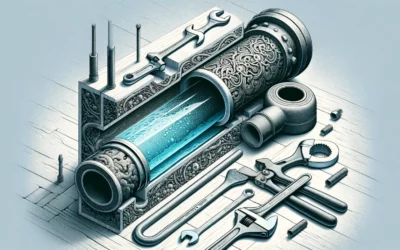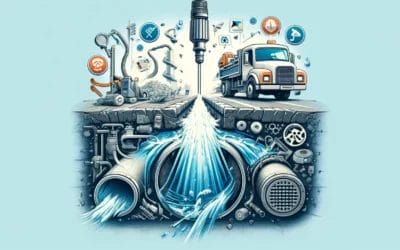Welcome! In this post, you will find a comprehensive understanding of underground natural gas pipe corrosion from the perspective of an expert plumber. This informative and fact-based discourse aims to educate you on the causes, effects, and prevention methods of corrosion in gas pipelines. Whether you’re a homeowner, a professional in construction or plumbing, or anyone interested in this area, this post is designed to be a helpful resource. Here, we reveal the otherwise hidden complexities of utility systems that lie beneath our feet and solidify your understandings in an easy, digestible manner. Read on to gain valuable insights and actionable tips to prevent costly repairs and prolong the lifespan of your underground natural gas pipes.
Understanding the Basics of Underground Natural Gas Pipe Corrosion
Many consumers and industry professionals are unaware of the driving forces behind underground natural gas pipe corrosion. To effectively prevent catastrophic failures, it is crucial to comprehend the key factors that influence the corrosion process. Essentially, pipe corrosion can be attributed to a combination of environmental conditions, material properties, and the electrochemical reactions that occur in and around the pipe.
Several environmental parameters play a critical role in the corrosion process. Firstly, the soil’s composition - its chemical and physical properties, moisture content, and temperature variations – can induce or accelerate corrosion. Secondly, other external elements, such as air quality and bacterial activity, can interact with the pipe material leading to corrosion. In the same vein, the pipe’s material and quality also significantly dictate the speed and severity of corrosion. Certain materials, especially those containing iron or its alloys, are heavily prone to corrosion. The pipe’s quality can also influence corrosion, as older, lower-quality pipes may not have protective coatings or may have manufacturing defects that expedite the corrosion process.
| Corrosion Influencing Factors | Description |
|---|---|
| Soil Composition | Chemical & physical properties of soil, including moisture and temperature, impact corrosion |
| Environmental Conditions | Air quality, bacterial activity, and other external elements can accelerate corrosion |
| Pipe Material | Materials, especially those with high iron content, are susceptible to corrosion |
| Pipe Quality | Older, substandard pipes lacking protective coatings are more prone to corrosion |
Finally, the process of corrosion is majorly an electrochemical reaction. When the pipe material comes into contact with an electrolyte (like water), an exchange of ions can occur, leading to the slow dissolution of the pipe. This reaction is further amplified in the presence of ionizing elements (like oxygen and salt), which accelerate this natural process. Therefore, to effectively forestall underground natural gas pipe corrosion, it is crucial to manage these primary sources of corrosion proactively.
Expert Insight into Causes and Effects of Pipe Corrosion
Corrosion in underground natural gas pipes is a menace that can lead to an array of potentially hazardous situations. It is an all too often occurrence which, in many cases, is utterly preventable. In the world of plumbing, three primary factors contribute to pipe corrosion: chemical reactions, galvanic responses, and microbiologically influenced corrosion (MIC). Chemical reactions occur when the pipe material comes into contact with soil or water having a high concentration of corrosive elements such as chlorides, sulfates, or low pH levels. Galvanic corrosion arises when two dissimilar metals are in contact, creating an electrical current that speeds up rusting. Finally, MIC is caused when certain bacteria attach themselves to the pipe surfaces, resulting in rapid corrosion. However, it’s not enough to just understand the causes; the effects of pipe corrosion need to be tackled too. Pipe corrosion can lead to numerous problems, the most severe being gas leaks which can cause explosions. Besides that, there can be contamination of the gas stream, affecting the quality of the gas supplied. This can lead to decreased efficiency of appliances, elevated maintenance costs, and even health risks. More frequently, pipe corrosion results in a reduction in pipe wall thickness, subsequently lowering the pressure carrying capacity and lifespan of the pipe. Even though these effects are often substance and situation specific, it cannot be stressed enough how important it is to prevent pipe corrosion in the first place. Here is a simplified table to summarize the aforementioned points:
| Causes of Corrosion | Effects of Corrosion |
|---|---|
| Chemical reactions | Gas leaks |
| Galvanic corrosion | Contamination of gas stream |
| Microbiologically Influenced Corrosion (MIC) | Reduction in pipe wall thickness |
While the concerns are genuine, preventing or controlling corrosion with appropriate measures like using corrosion-resistant materials, regular inspections, and timely maintenance is the logical and safest way forward.

Potential Implications of Natural Gas Pipe Corrosion
Corrosion of underground natural gas pipelines can lead to a multitude of problems, with potentially serious implications. Leakages and ruptures can occur, which directly compromise the functionality of the pipeline. This subsequently leads to service disruption, potentially putting homes, businesses, and industrial operations in the vicinity at a standstill.
Even more alarming, is the potential risk of explosions that can result from escalating gas leakages. These could lead to property damage, injuries or even loss of life. Furthermore, the associated repair, as well as potential litigation costs, could prove financially burdensome. Corrosion also reduces the lifespan of these pipelines, necessitating premature replacements, which brings about a significant financial implication.
It is thus essential to mitigate pipe corrosion through measures such as:
- Utilizing cathodic protection systems
- Employing protective linings and coatings
- Conducting regular pipe inspections
- Implementing efficient corrosion inhibitors
| Technique | Objective |
|---|---|
| Cathodic Protection | Reduces the potential and current of the corrosion process. |
| Protective Linings and Coatings | Prevents the contact between the corrosive soil and the pipe. |
| Regular Inspections | Early detection of potential deficiencies or leaks. |
| Corrosion Inhibitors | Minimizing or eliminating corrosion damage. |
In conclusion, the risks associated with the corrosion of underground gas pipelines are significant. As such effective monitoring and management to mitigate these risks is of utmost importance.
A Plumber’s Approach to Detecting Symptoms of Pipe Corrosion
When it comes to detecting early signs of pipe corrosion, a plumbers’ daily experience is invaluable. Several factors lead to pipe corrosion, including the chemical composition of soil, the presence of bacteria, condensation, and the soil’s texture. It’s critical to catch these signs early to help prevent gas leaks and other dangerous situations.
As a plumber, the first telltale signs of pipe corrosion you may encounter include discoloration, flakes, and dimpling on the surface of the pipe. A metallic or acidic smell may also occur near the corroded areas and can indicate further damage inside the pipe. Below are a few visual cues:
- Discoloration: Often manifests as areas of the pipe turning into a brown or green color.
- Flakes: As corrosion worsens, the pipe starts to flake, literally shedding layers of metal.
- Dimpling: This appears as small dents or bumps on the surface of the pipe.
These signs may not always be visibly detectable, especially when dealing with underground natural gas pipes. Having tools that can perform non-destructive testing (NDT) can help in these hard-to-reach areas. These include electromagnetic devices, ultrasonic testing tools, and microscopy among others.
| Tool | Use |
|---|---|
| Electromagnetic Devices | Used to detect changes in the pipe’s magnetic field which indicate the presence of corrosion. |
| Ultrasonic Testing Tools | Uses sound waves to detect changes in the pipe’s thickness, signaling corrosion. |
| Microscopy | Removes a small sample from the pipe to examine under a microscope for signs of corrosion. |
By coupling your observational skills as a licensed plumber, with these advanced tools, early detection of pipe corrosion becomes feasible, aiding prevention processes.
Recommended Preventive Measures for Natural Gas Pipe Corrosion
Proper practices to prevent pipe corrosion are crucial for maintaining the long-term reliability and safety of your natural gas pipelines. One important method is to apply a protective coating or wrapping to the outside of your pipes. Materials commonly used for this purpose include fusion bonded epoxy, polyethylene, and zinc. These coatings serve as a physical barrier, preventing corrosive substances from coming into direct contact with the pipe metal.
Another recommendation is to use cathodic protection. This control technique involves creating an electrochemical cell that reduces the corrosion rate of your gas pipe by shifting its potential to a more noble value. Cathodic protection can be effective in controlling corrosion on both the interior and exterior surfaces of your pipes. It’s often used in conjunction with protective coatings to provide superior corrosion prevention.
The below illustrates these two principal methods of corrosion control:
| Method | Description |
|---|---|
| Protective Coating/Wrapping | Coating or wrapping the outside of the pipe with protective materials, such as polyethylene, zinc or epoxy, to act as a physical barrier against corrosion. |
| Cathodic Protection | Electrochemical technique used to reduce the corrosion rate by shifting the pipe’s potential. Often used alongside protective coatings for superior corrosion control. |
In addition to these methods, you can implement regular inspection and maintenance schedules to catch minor issues before they escalate. This includes checking for leaks, visually inspecting for signs of deterioration, and conducting integrity testing. Consider contacting a professional plumber with experience in gas pipe corrosion prevention and repair to help guide you through the process.
Effective Repair Methods for Corroded Natural Gas Pipes
When it comes to addressing corroded natural gas pipes, there are several effective methodologies in practice. First and foremost is Regular Inspection. This preventative measure entails routine monitoring of the pipeline network to catch any signs of corrosion in its infancy. Cathodic Protection is another commonly used method. This involves attaching sacrificial anodes to the pipe which allow the anode to corrode in place of the pipe, ensuring the longevity of the gas lines. It is also essential to prioritize the removal of any factors which could contribute to corrosion. This might include Aqueous Environments, or areas of high moisture, as well as Soil Conditions known to propagate rusting.
| Solution | Effectiveness |
|---|---|
| Regular Inspection | High |
| Cathodic Protection | High |
| Remove Corrosive Factors | Medium |
For severely corroded sections, a complete pipe replacement might be the only solution. However, rather than disrupting the entire pipe network, targeted replacements like the Trenchless Pipe Lining can effectively restore pipe function without causing significant inconvenience. Another innovative solution is the Anti-corrosive Coatings. These can be applied to the internal surface of the pipes to provide an extra layer of protection against corrosion. Their high resistance to chemicals and excellent adhesion to the base material make them a highly efficient method of repairing corroded natural gas pipes.

Evaluating the Long-term Impact of Gas Pipe Corrosion on Plumbing Infrastructure
Corrosion is a natural process that directly affects the structural integrity of gas pipes and, in the long run, the whole plumbing infrastructure. The rate at which this degradation occurs significantly dependents on the surrounding environment, the type of soil, the pipe material, and the security measures in place. In essence, understanding the dynamics of natural gas pipe corrosion helps to predict and manage its impact effectively.
Most commonly, iron pipes are used in underground gas supply networks. The unique properties of iron offer a remarkable balance between affordability and durability. However, iron is susceptible to oxidation, which results into corrosion. Regular inspection and maintenance practices help to monitor these potential hazards as well as implementing precautionary measures such as using cathodic protection and protective coatings on the pipes.
The corroded portion of a pipe forms a lattice-like rust that eats away the iron, reducing the pipe wall thickness and leading to gas leaks. The following table illustrates the impact of gas leakage on the plumbing infrastructure.
| Impact | Explanation |
|---|---|
| Safety Hazards | Gas leaks pose a significant safety risk, including potential fires and explosions. |
| Environmental Pollution | Uncontrolled release of gas contributes to greenhouse gas emissions. |
| Financial Losses | Unscheduled maintenance and replacement of pipes result in added costs. |
| Reduction in Service Quality | Leaks affect gas pressure, thus undermining the efficiency and reliability of the gas supply system. |
In conclusion, implementing an active approach in monitoring and managing underground gas pipe corrosion is pivotal to not only enhance the service life of the infrastructure but to ensure environmental sustainability and safety as well.
Concluding Remarks
In conclusion, understanding underground natural gas pipe corrosion is crucial for every homeowner and plumbing professional to ensure safety and maintain the longevity of gas pipelines. A keen insight in recognizing early symptoms of corrosion and implementing appropriate protective measures can go a long way in avoiding hazardous incidents and unexpected expenses. The information shared in this article, with insights derived from plumbers’ real-life experiences, aims to educate and enlighten readers about the various aspects of natural gas pipe corrosion. Remember, knowledge is power. By staying informed and making timely decisions, we can protect our infrastructures, keep our families safe, and contribute to a cleaner, greener environment. Let this be a welcome guide to understanding the intricacies of pipe corrosion and handling them effectively. Keeping learning, keep growing, and stay vigilant!









